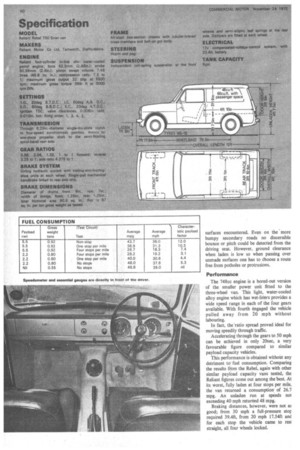RELIANT REBEL 750 5CWT VAN
Page 45

Page 46

Page 47

If you've noticed an error in this article please click here to report it so we can fix it.
by Trevor Longcroft
MENTION the name Reliant and many people will think of a three-wheeler. However, since the mid-Sixties Reliant has produced a four-wheel, live rear-axle saloon called the Rebel, and this year at the Earls Court Commercial Motor Show the company launched a 5cwt capacity van version with a grp body mounted on a traditional hand-built all steel chassis.
Load capacity is 46 cu ft — 60 cu ft without a passenger seat. Access to the load space is through a single slam-door at back. However, for a test over CM's route for small vans, the -optional passenger seat — and radial tyres — were fitted.
Both the interior and exterior lines of the vehicle are clean and neat. Inside, the seats are firm and remain comfortable even when one is driving for a long time. The ample forward and back adjustment provides an excellent driving position. The gear lever projects rearward from the ' front of the transmission tunnel, the• handbrake is conveniently located between the passenger and driver seats. The pedals are not obstructed by the steering column, but are, closer together than I would like. During one full-pressure stop I inadvertently depressed the throttle as well as the brake pedal.
The well laid out dashboard panel has only a few gauges and controls; the windscreen wiper, washers, heater and boost fan controls are located on the centre panel of the dashboard just above the choke. The speedometer is to the offside of the steering column; fuel and water temperature gauge, ignition and oil warning lights are under one glass to the nearside of the column. Driving lights and the ignition switches are on the offside of the dashboard and the direction indicators are operated from a stalk projecting from the right side of the 'column.
The van is based on a saloon car but was not particularly quiet, especially when starting from cold; there is no noise insulation on the bulkhead.
When pulling away from rest transmission noise, notably on the lower ratios, added to the noise nuisance. However, once the engine had reached its normal running temperature the vehicle became quieter and the noise level reduced to a much more acceptable level.
Ride and handling
Positioning of the wing mirrors made it impossible to get a clear. view of the traffic behind without moving my head. A more satisfactory arrangement for a van would be to have larger wing-mirrors and an additional mirror mounted on the driver's door in order to help, as the swept arc of the wipers left an unswept area of glass which obscured the wing mirror.
Whether laden or unladen steering was normally light and accurate, but above 60 mph on motorways unusually high winds seemed to lift the front of the vehicle, especially when passing high-sided vehicles. Otherwise the handling was good and the van cornered in safety, no understeer or oversteer occurring with the vehicle laden. The suspension coped easily with all road surfaces encountered. Even on the more bumpy secondary roads no discernible bounce or pitch could be detected from the driving seat. However, ground clearance when laden is low so when passing over unmade surfaces one has to Choose a route free from potholes or protrusions.
Performance
The 748cc engine is a bored-out version of the smaller power unit fitted to the three-wheel van. This light, water-cooled alloy engine which has wet-liners provides a wide speed range in each of the four gears available. With fourth engaged the vehicle pulled away from 20 mph without labouring.
In fact, the 'ratio spread proved ideal for moving speedily through traffic.
Accelerating through the gears to 50 mph can be achieved in only 20sec, a very favourable figure compared to similar payload capacity vehicles.
This performance is obtained without any detriment to fuel consumption. Comparing the results from the Rebel, again with other similar payload capacity vans tested, the Reliant flip-es come out among the best. Al its worst, fully laden at four stops per mile. the van returned a consumptionof 26.7 mpg. An unladen run at speeds not exceeding 40 mph returned 48 mpg.
Braking distances, however, were not a: good; from 30 mph a full-pressure stor required 39.4ft, from 20 mph I7.54ft and for each stop the vehicle came to rest straight, all four wheels locked. The handbrake is mechanically linked to the rear wheels and held the vehicle on a I in 6.5 gradient; it returned a 49 per cent efficiency Tapley meter reading when used to stop from 20 mph.
Summary
The Reliant Rebel is a well-designed van with clean exterior lines and has a neatly laid out interior. The grp body obviates any rust corrosion problems, and minor body repairs can be completed -by an amateur with a fibreglass kit.
In terms of performance the owner will get a vehicle which has a thirst for work — but not for fuel. The standard model costs £685 as tested with passenger seat, seat belts, radial tyres; painted it costs £726.50.












































































































